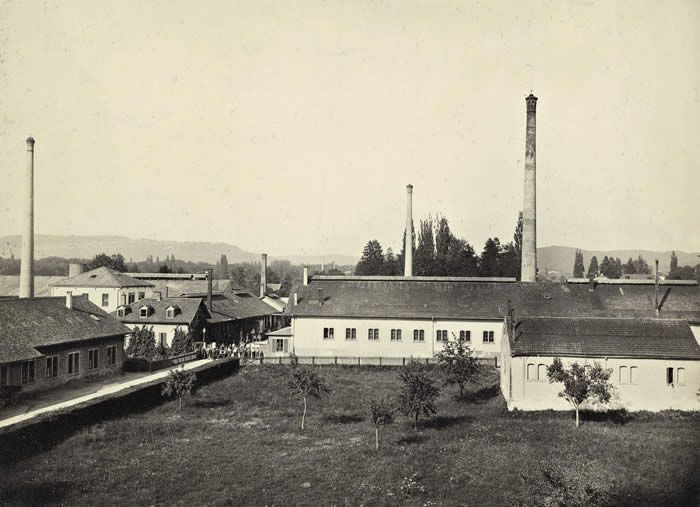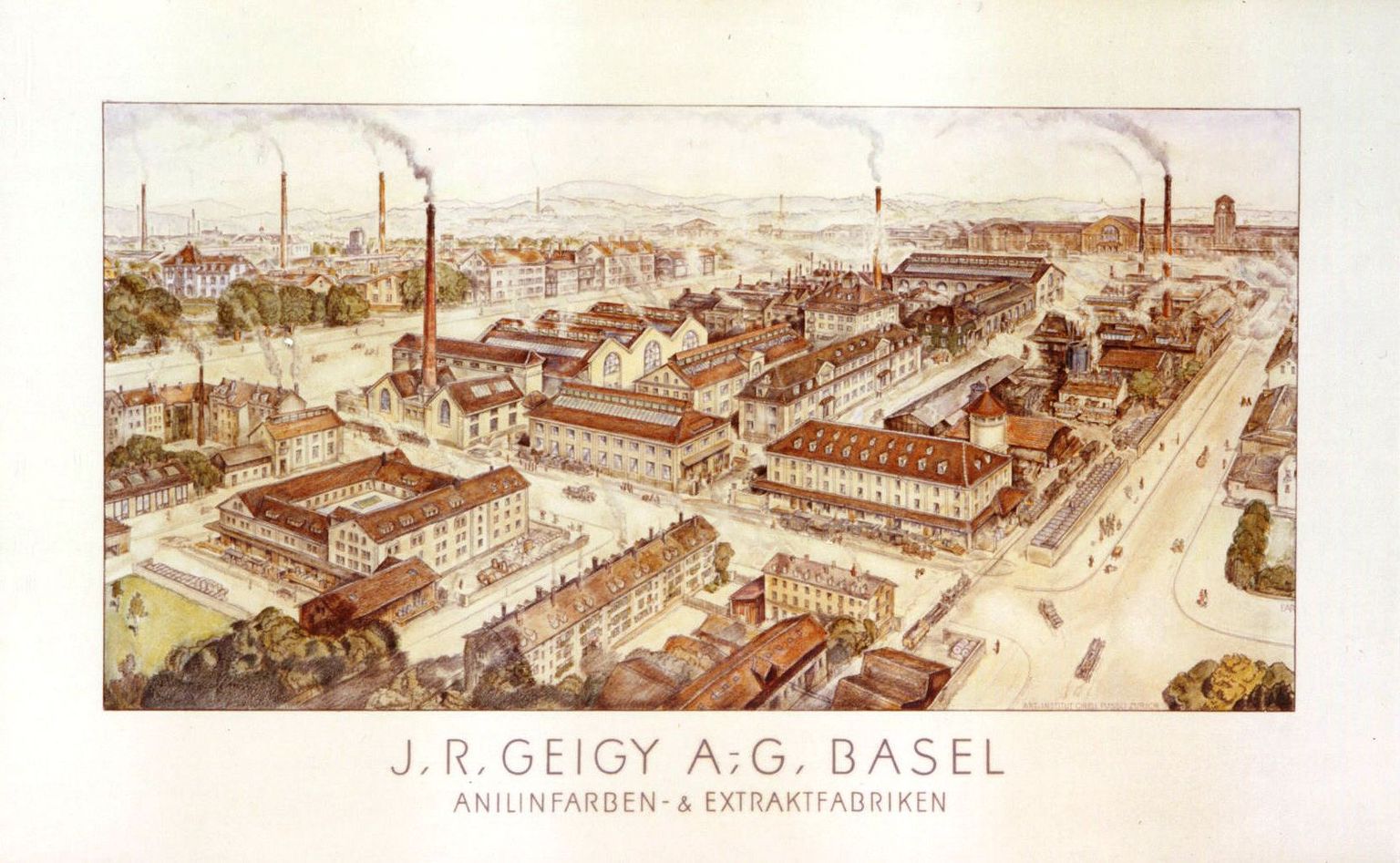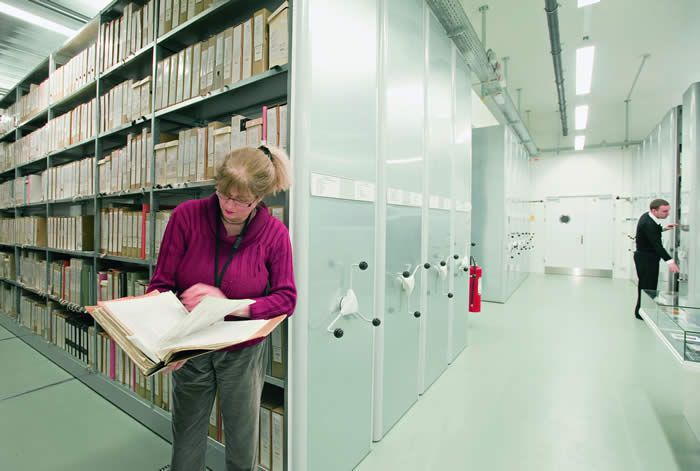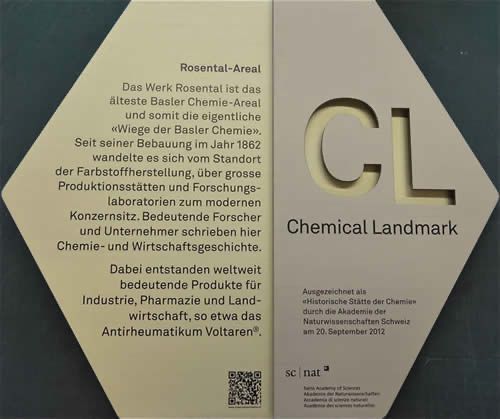Chemical Landmark 2012
Cradle of the Basel Chemical Industry
Designated as «Chemical Landmark» on 20 September 2012.
The fourth «Chemical Landmark» award in Switzerland was a double tribute and went to Basel: on one hand, the Rosental site as the real "cradle of the Basel chemical industry" was awarded - on the other hand, the importance of the company archive of Novartis was honoured as a collection of artefacts.
Rosental site
The Rosental site is the oldest of the still existing chemical facilities in Basel. In 1862 J. J. Müller & Cie., a spin-off company of J. R. Geigy AG, built on the »Rosental-Matten» a modern factory for the production of synthetic dyes.

In 1888 Traugott Sandmeyer joined the company and contributed with his methods significantly to the success of the company. At the beginning of the 20th century the site was enlarged in various directions by new production plants. In the 1930s they started with the insecticide research and production, which was crowned by the discovery of dichlorodiphenyltrichloroethane (DDT) by Paul Hermann Müller (Nobel Prize 1948). Shortly afterwards, fungicides and seed treatments as well as pharmaceutical products followed.

In the middle of the last century the site was further enlarged with laboratory and office buildings. The production at the Rosental site was discontinued in the 1960s and was moved to Schweizerhalle. Therefore production buildings were demolished and further research laboratories were built. In the 1950s and 1960s the pharmaceutical research was mainly successful in the development of anti-inflammatory anti-rheumatic agents: Butazolidin®, Tanderil® and especially Voltaren® are internationally known products.
Since about 1980 the Rosental site changed more and more into the headquarters of Ciba-Geigy, Novartis and finally Syngenta. In 2007, the last of Syngenta research laboratories were relocated. Currently more than 30 companies and academic institutions in the field of life sciences are located adjacent to the headquarters of Syngenta at the Rosental site. But next to all these, there is one of the oldest buildings still present on site, and reminds visitors and employees of the rich history of the chemical industry in Basel.
Company Archive of Novartis
As the oldest company archive in Switzerland the one of Novartis AG holds the patrimony of all its predecessor companies back to the 1860s. By name, these are the archives of the following independently grown companies: J.R. Geigy AG (founded 1758), Durand & Huguenin AG (founded 1872), Ciba Ltd. (founded 1884) and the integrated predecessor companies, Sandoz AG (founded 1886) including the integrated Wander AG (from 1967), Ciba-Geigy AG (merger 1970) and Novartis AG (Fusion 1996).

A large part of the history of the Basel chemical and pharmaceutical industry is collected, catalogued and safely stored here. Nevertheless, it is made accessible to researchers, historians and other interested parties. The company archive also ensures that future generations can access the stored documents and strives to protect the assets from decay, destruction and theft.
The archive include a broad range of written and non-written records, including certificates of foundation, contracts, annual reports, minutes if board meetings, audit reports, investment plans, statistics, staff lists, organizational regulations, site and building plans, product packagings, as well as classical and digital picture and sound files. Furthermore the Nobel Prize medal of Paul Hermann Müller as well as earliest pharmacological agents and an extensive collection of advertising and product design are stored in the archive. The archive currently holds 2600 running meters of processed files and 700 running meters of uncategorised entries.
With its historic collections, the company archive of Novartis provides the comprehensive memory of the outstanding achievements and services of the chemical and pharmaceutical industry of Switzerland.
The ceremony was held on September 20, 2012. Close to 120 persons followed the invitation, including many former and current employees of Novartis AG and Syngenta AG, as well as personalities from politics and economy of Basel. The celebration started at the Rosental site, where Prof. Dr. Felix Escher, Vice President of the Swiss Academy of Sciences (SCNAT), warmly welcomed the guest. In his laudation Prof. Dr. Hans-Jürgen Hansen, emeritus professor of organic chemistry at the University of Zurich, acknowledged the importance of the Rosental site in the history of the chemical industry here in Basel. After the unveiling of the commemorative plaque, Christoph Mäder, member of the executive board of Syntgenta AG, thanked the SCNAT for the designation and emphasised again the historical importance of the Rosental site for the chemical industry and its development in Basel.

At the end of the first part of the program the audience had the opportunity to visit an exhibition about the Rosental site, which was especially created for this event.
The second part of the program began shortly afterwards on the Novartis Campus. After a welcome and a brief introduction to the program «Chemical Landmarks» by Prof. Dr. Karl Gademann, Walter Dettwiler, director of the company archive of Novartis, gave a detailed presentation about the history of the chemical and pharmaceutical industry in Basel using numerous pictures from the archive and thereby illustrating the importance of this institution. The laudation of Prof. Dr. Dieter Seebach, emeritus professor of organic chemistry at ETH Zurich, emphasised the role of the company archive. After the revelation of the second commemorative plaque, Pascal Brenneisen, Country President Switzerland of Novartis AG, thanked the SCNAT for the designation and emphasised again the importance and relevance of the chemical and pharmaceutical industry for the metropolitan area of Basel as well as for the Swiss economy.
Press release (German/ for the French version, please switch to FR [top right of page])
Brochure "The history of the Rosental site in Basel"
Media coverage
- Basler Zeitung - 21.9.2012, p. 38
ChemieXtra
- SCG / SSC / SCS
- Vogel Gryff - 27.9.2012, p. 9
CHIMIA 2013, 67, p. 298
